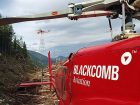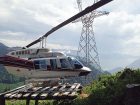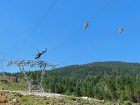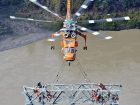
News
Powering British Columbia
July 29, 2015 By Paul Dixon
The history of electrical generation and distribution in British Columbia is a series of construction projects ranging from “big” to “really big.” One of the largest projects in decades is the new ILM (Interior to Lower Mainland) 500KV high-voltage line. The new line parallels an existing 40-year-old 500KV line on a 247 kilometre journey from the Nicola sub-station outside Merritt in B.C.’s Interior to the Meridian substation in the Vancouver suburb of Coquitlam.
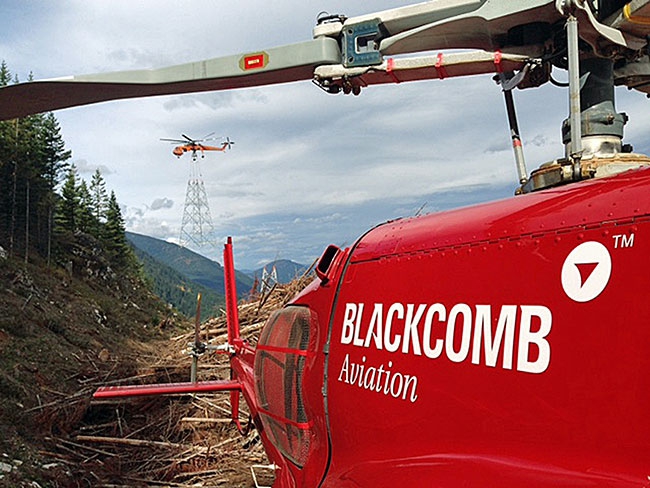 Blackcomb Aviation’s A335N on standby. The history of electrical generation and distribution in British Columbia is a series of construction projects ranging from “big” to “really big.”
Blackcomb Aviation’s A335N on standby. The history of electrical generation and distribution in British Columbia is a series of construction projects ranging from “big” to “really big.”Like an advancing army of skeletal robots, 641 giant steel towers seem to march over towering mountain peaks and down across valley floors on their journey from the semi-arid scrubland of B.C.’s Interior down to the coastal rain forest. BC Hydro’s current power transmission system was built during the 1960s and ’70s. The ILM project is the first 500KV transmission line built in Western Canada in more than 25 years.
Most of the dams and generating stations in B.C. are located far from the population centres of the Lower Mainland and Vancouver Island. Expanding the capacity of the transmission system will meet future demands for power on a wide scale, as B.C. is part of the Western Interconnect, an interconnected power grid serving B.C., Alberta, western U.S. states and parts of northern Mexico. Construction of the ILM is part of a forward-planning process looking ahead as far as 30 years into the future.
When the ILM is energized next year, it will be more than a decade since work first started on the project. Much has changed since the original 500KV line on this route was erected more than 40 years ago. While planners had the foresight to make the right-of-way wide enough to accommodate a second line in the future, there has been a significant shift in process since then. Environmental assessment took more than three years and the public consultation process which included 60 First Nations saw numerous court challenges before approval was finally granted.
Given the challenging geography of the province, helicopters are an essential tool in BC Hydro’s operations across the province. The utility has been proactive in implementing safety protocols to minimize the risk and maximize safety in helicopter operations for its employees, contractors and the public. Hydro’s Aviation Operations Department was recognized for its leadership role in aviation safety, with the awarding of the 2014 Back and Bevington Air Safety Award by the B.C. Aviation Council. The award is presented annually to an organization that “demonstrates the most significant contribution to air safety in areas like aircraft operation/design, accident investigation/prevention, flight training, engineering and airport operation/design in the province of B.C.”
Devin Dukeshire, BC Hydro’s transmission field operations manager for the ILM Project, spoke with Helicopters about the thought and preparation that goes into every project. In the end, success is predicated on relationsips. “A lot of the (rotary) vendors are organizations we have used throughout the years and we’ve built those relationships,” Dukeshire said. “On this project, we’ve had multiple vendors and helicopters – lights, mediums, heavies and extremes, right through the whole project.”
At Hydro, all employees or contractors who use helicopters have to have basic helicopter training. “Basic training,” as Dukeshire explains, “is just to give people awareness, something more than a simple pilot refresher before you jump into the helicopter.” There’s a test that concludes the training as part of the rigid documentation process. The basic course is just that, intended primarily for anyone getting in or out of a helicopter. Beyond that, there’s multi-day training for everyone working in the wires, power line patrols, vegetation or aerial surveys in and around the power line system.
While this training is good for three years and applies to both contractors and pilots, it simply allows you to get into a helicopter and fly a patrol. Beyond that, Dukeshire notes, there’s specific training and sign-off for more complicated procedures. “We have more than 20 procedures in place, from installing sock lines, hover exit, touch and go, Class D – all that stuff. You have to be trained in that as well if you want to work under the helicopter or from the helicopter. The procedures were developed with the Field and Aircraft Operations people in our Work Methods Department.”
Andrew Bradley, vice-president of operations for Blackcomb Aviation, has considerable experience working with BC Hydro. When it comes to safety, they always take a leadership role. “They make sure what we are doing and what we’re supposed to be doing, is right. And not just us, but their own managers from BC Hydro as well. It’s always a work in progress.”
Brad Fandrich, general manager of Valley Helicopters, has been involved with the ILM project from its inception. Several types of helicopters and operators have been used, and it’s fascinating to see the various aircraft working in unison.
“There’s been a lot of different helicopter types, a lot of different operators and it’s certainly an interesting time,” Fandrich says. “Helifor did a lot of clearing of the right of way, so they were using their Vertol and flying fallers in with a 500. Mustang had a 214B doing legs and concrete work. Heliquest came in with a 205 and the K-Max for logging, hanging some glass and doing some legs. VIH had a Kamov doing legs and some other heavy lift such as excavators. Ascent has had a 212, Twin Ranger and 902 doing a lot of the wire in the towers.”
As for Valley, the company started moving crews of surveyors and archaeologists using its 407 and then focused on construction crews, slinging in diesel fuel for their excavators, wood for the forms, then the concrete. Once the foundations were done, Fandrich says, the steel went up and Valley started flying sock line. “We’ve pulled 90 per cent of the sock line for the wire that’s up so far and now we support the crews working on the dead end towers, flying in nuts and bolts. We fly the spacers up to the guys in the carts.”
Every job in the Hydro universe, every lift, every little detail, goes through a booking process. On the IML project, every request or booking for a helicopter goes through Dukeshire or his designate. “We select the helicopter based on the task,” he says. “Then we pick a pilot that has the hours associated to the task we’re doing. We fill out an approval form, a booking list and then we send it through to our aircraft operations department and they will vet it. They make sure the operators are approved for the task and that they have the hours associated to the task, whether it’s
long-lining, changing insulators or whatever it might be. Then they double-check the helicopter to make sure it meets the requirements for the lift.”
That’s the process for every movement on the project. In terms of matching pilots to the work crews on a job, this process is equalling precise. “They are very, very particular,” Fandrich says. “When they get a pilot they’re comfortable with, they want to take the same days off. We try and give them a couple of pilots they can work with, we don’t just randomly select pilots.
“On a bigger scale, when we have the Erickson Skycrane, we actually build a flight plan. We vet every single pick that goes through aircraft operations for approval as well. Elevation, weight of the load, all the stuff we’ll be faced with out in the field.”
The Great Divide
The most challenging section of the project is around Spuzzum in the Fraser Canyon about 30 kilometres northeast of Hope. Some 80 per cent of the work in this section is done by helicopter only, as towers in this section are much bigger than anything used previously by BC Hydro, Dukeshire says.
“They are known as 10J structures, which weigh more than 200,000 pounds,” he says. “They are perched up on top of bluffs where there is no way to get cranes or trucks up there. We had to figure out how to break that tower down so we could fly it with the Skycrane in 20,000 pound loads.”
Hydro engineers worked with Erickson’s engineers and devised a way to break the tower down into 12 pieces. Six different helicopters were used to move these parts at once just for this portion of the project: a 212, 214, 902, Skycrane, 407 and an AStar. The coordination was a challenge, trying to coordinate it all with the pilots.”
What made this phase of the job even more challenging was there were men up working in the steel, catching and bolting every piece that came in, leaving no room for error. Dukeshire is unreserved in talking about the skill level required of the pilots to allow him to put his workers up on the steel.
“There are 15 to 20 men up a tower who were catching 20,000 pound pieces of steel with very little room for error,” he says. “There was a great deal of confidence in those pilots. Every tower and every site is different, there’s no common ground and it was really good.”
Adding to the safety factor all Hydro’s people up on the towers are Class D, which has become the norm within BC Hydro for people working anywhere on the transmission system. As Dukeshire points out, most of the work takes place in remote locations, making Class D rescue the only viable way of attending to injured workers who otherwise couldn’t be removed from a job and moved to first aid or flown direct to hospital.
For the ILM project, Blackcomb Aviation has had its A355N involved in the process on a daily basis on standby rescue service. Blackcomb does more work with BC Hydro on an annual basis than any other operator. Bradley says his team is doing a little bit of everything.
“We do tough and goes, putting guys on top of towers by touch and go, slinging them spacers on the buggies. We’ve been there every day, almost 10 months. The A355N is certified to do the tough and go and has the oomph to sling a lot of gear around.”
Specialty Assignments
Trent Lemke, president of Ascent Helicopters says his operation has also been busy on the project since its inception, with up to five aircraft working at any one time on various jobs. Lemke has been flying his 902 as a spotter for the Aircrane, with a foreman from Hydro and someone from Aircrane with him to confirm that the load has been set properly before they release it. Lemke describes another Ascent specialty.
“We have a 212 that’s hoisting linemen onto the structures on a full-time basis, 12 hours a day, seven days a week,” he says. “These towers are very tall towers, the two outer phases are 60 to 70 feet below the centre phase. By hoisting, they can move people around without them having to climb up and down. It’s really saved the productivity of the program, using the hoist. This is the first time that hoisting has been used on such a large-scale project. I think we’ve done close to 10,000 hoists on this project. The numbers are staggering and it has proven itself.”
If the Spuzzum section as a whole is the most challenging, there is one section where the line sweeps down from a mountain top, plunging deep into the canyon below before rising on the other side. Dukeshire says it’s more than 1.1 kilometres between pylons here, as the lines cross the Fraser River, the Trans-Canada Highway, CN Rail on one side of the river and CP on the other. Then there’s a second 500KV line, as well as a 60KV line, that the new line has to be strung above.
“It was a pretty nerve-wracking scenario,” Dukeshire recalls. “We weren’t allowed to shut down the railroads when we were flying sock line and their lines are active all the time. The 500KV line was de-energized, but we couldn’t de-energize the 60KW line. There was potential to drop the sockline into the river or the energized line and that would have been catastrophic.
“When we flew the line, the pilot in the 212 had to take it up really, really high because the bag of the line is well below the helicopter. He had to take it up and then basically hit the brakes on the baby line puller, and then the pilot had to guide it down through into the tower. The pilot had to be aware of how high he was and how far he had to go back down to the tower without letting too much line out to back into the energized circuits or the river.”
There are five major river crossings along the ILM. In one section, Dukeshire says that due to access issues, there was a 10-kilometre sock line pull by helicopter. “There were very unique scenarios that we had never seen before in British Columbia.”
Well-Deserved Accolades
Dukeshire is effusive in his praise of everyone involved in helicopter operations on the ILM project. He stresses that there were multiple levels of support every step of the way by the pilots and their aircraft. “They work long hours and they are there every day,” he says.
For Fandrich, it’s been impressive to watch the process as it has all come together. “The air crews have been remarkably professional with each other, a very good team job between the air crews for most of it. The guys that are doing every task are at their A-game, they’re at the top of their careers right now.”
Fandrich’s sentiments have been echoed by everyone involved in this project – a professional group of operators, pilots and personnel dedicated to a common, powerful goal.
